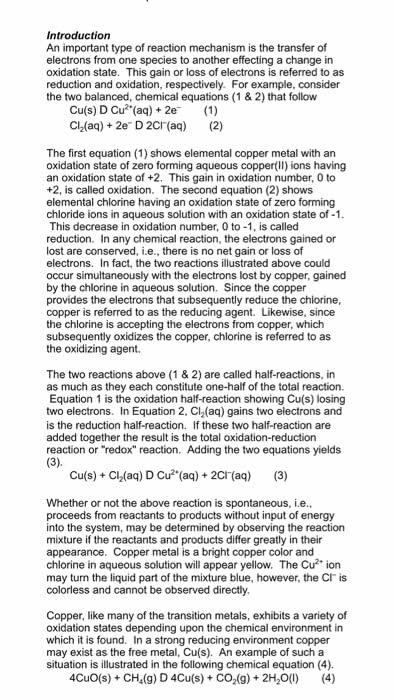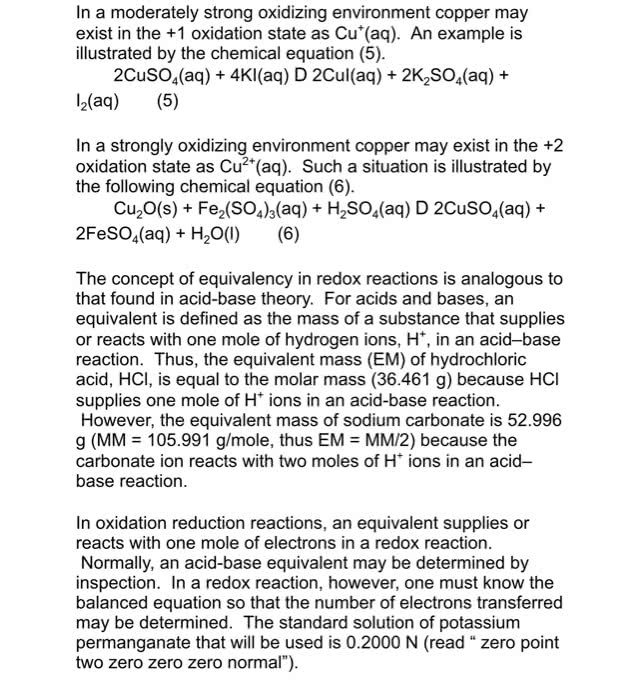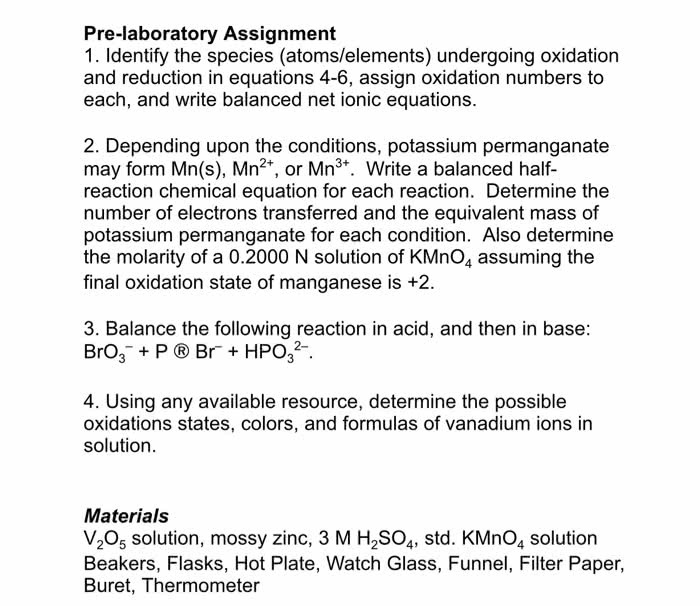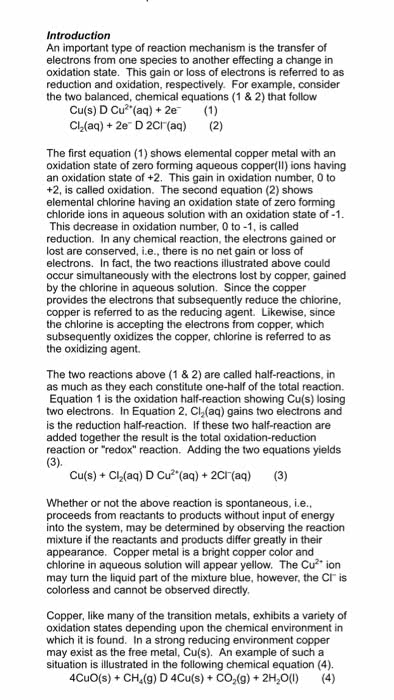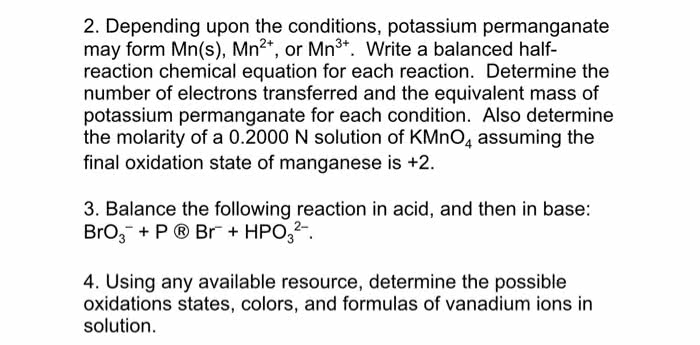Initial observations: before beginning Observations Observations after 30 minutes Chemical equation Element that is oxidized Element that is reduced Spectator ion Oxidizing agent Reducing agent www.HOLscience.com 16 ©Hands-On Labs, Inc. Experiment Oxidation-Reduction Activity Series Questions A. Define oxidation, reduction, and oxidation number. Describe how oxidation and reduction affect the oxidation number of an element. B. Define oxidizing agent, reducing agent, and spectator ion. C. In the reaction of copper and silver nitrate, a new substance appeared in the test tube. Describe the physical appearance of the substance and identify its chemical formula. D. Given an activity series in which the most active metals are at the top of the list and the least active metals are at the bottom of the list, would copper be listed above silver or would silver be listed above copper? Support your answer with data from Data Table 1. E. Solid copper sulfide and silver nitrate react to form copper (II) nitrate and solid silver sulfide. Write a balanced chemical equation that describes the reaction. Identify the oxidation number of each element in the reaction. (You do not need to include the total contribution of charge.) Is this reaction a redox reaction or a non-redox reaction? Explain your answer. www.HOLscience.com 17 ©Hands-On Labs, Inc. Experiment Oxidation-Reduction Activity Series Exercise 2: Creating an Activity Series Data Table 2. Redox Reactions of Copper, Lead, and Zinc Solid metal Well ID Solution Immediate observations 30 Minute Observations Cu A1 Pb(NO3 ) 2 A2 Zn(NO3 ) 2 Pb B1 CuSO4 B2 Zn(NO3 ) 2 Zn C1 CuSO4 C2 Pb(NO3 ) 2 Data Table 3. Potential Redox Reactions and Chemical Equations Metal and Metallic Solution Reaction Occurred? Chemical Equation Cu + Pb(NO3 ) 2 Cu + Zn(NO3 ) 2 Pb + CuSO4 Pb + Zn(NO3 ) 2 Zn + CuSO4 www.HOLscience.com 18 ©Hands-On Labs, Inc. Experiment Oxidation-Reduction Activity Series Zn + Pb(NO3 ) 2 Questions A. List each of the metals tested in Exercise 2. Indicate the oxidation number when each element is pure and the oxidation number when each element is in a compound. B. Which of the metals in Exercise 2 was the strongest oxidizing agent? Was there an instance when this metal also acted as a reducing agent? Explain your answer using data from Data Table 3. C. Which of the metals in Exercise 2 was the strongest reducing agent? Was there an instance when this metal also acted as an oxidizing agent? Explain your answer using data from Data Table 3. D. How does ease of oxidation correlate with activity? Do highly active metals tend to donate electrons or accept electrons from other metals? E. Create an activity series for copper, lead, and zinc. Place the most active metal at the top of the list.
Initial observations: before beginning Observations Observations after 30 minutes Chemical equation Element that is oxidized Element that is reduced Spectator ion Oxidizing agent Reducing agent www.HOLscience.com 16 ©Hands-On Labs, Inc. Experiment Oxidation-Reduction Activity Series Questions A. Define oxidation, reduction, and oxidation number. Describe how oxidation and reduction affect the oxidation number of an element. B. Define oxidizing agent, reducing agent, and spectator ion. C. In the reaction of copper and silver nitrate, a new substance appeared in the test tube. Describe the physical appearance of the substance and identify its chemical formula. D. Given an activity series in which the most active metals are at the top of the list and the least active metals are at the bottom of the list, would copper be listed above silver or would silver be listed above copper? Support your answer with data from Data Table 1. E. Solid copper sulfide and silver nitrate react to form copper (II) nitrate and solid silver sulfide. Write a balanced chemical equation that describes the reaction. Identify the oxidation number of each element in the reaction. (You do not need to include the total contribution of charge.) Is this reaction a redox reaction or a non-redox reaction? Explain your answer. www.HOLscience.com 17 ©Hands-On Labs, Inc. Experiment Oxidation-Reduction Activity Series Exercise 2: Creating an Activity Series Data Table 2. Redox Reactions of Copper, Lead, and Zinc Solid metal Well ID Solution Immediate observations 30 Minute Observations Cu A1 Pb(NO3 ) 2 A2 Zn(NO3 ) 2 Pb B1 CuSO4 B2 Zn(NO3 ) 2 Zn C1 CuSO4 C2 Pb(NO3 ) 2 Data Table 3. Potential Redox Reactions and Chemical Equations Metal and Metallic Solution Reaction Occurred? Chemical Equation Cu + Pb(NO3 ) 2 Cu + Zn(NO3 ) 2 Pb + CuSO4 Pb + Zn(NO3 ) 2 Zn + CuSO4 www.HOLscience.com 18 ©Hands-On Labs, Inc. Experiment Oxidation-Reduction Activity Series Zn + Pb(NO3 ) 2 Questions A. List each of the metals tested in Exercise 2. Indicate the oxidation number when each element is pure and the oxidation number when each element is in a compound. B. Which of the metals in Exercise 2 was the strongest oxidizing agent? Was there an instance when this metal also acted as a reducing agent? Explain your answer using data from Data Table 3. C. Which of the metals in Exercise 2 was the strongest reducing agent? Was there an instance when this metal also acted as an oxidizing agent? Explain your answer using data from Data Table 3. D. How does ease of oxidation correlate with activity? Do highly active metals tend to donate electrons or accept electrons from other metals? E. Create an activity series for copper, lead, and zinc. Place the most active metal at the top of the list.

